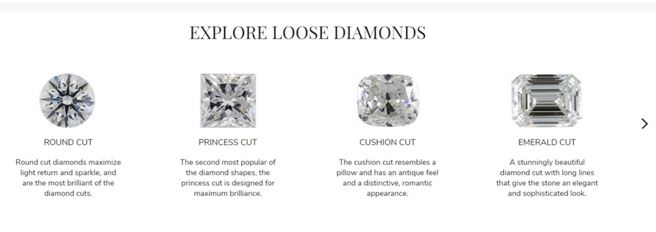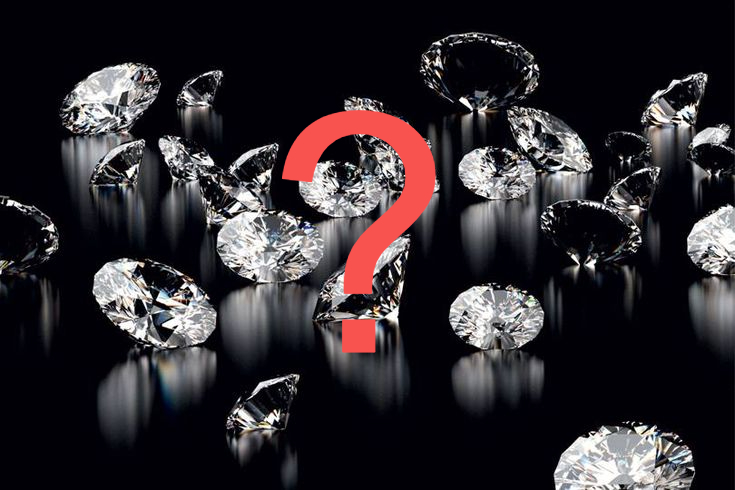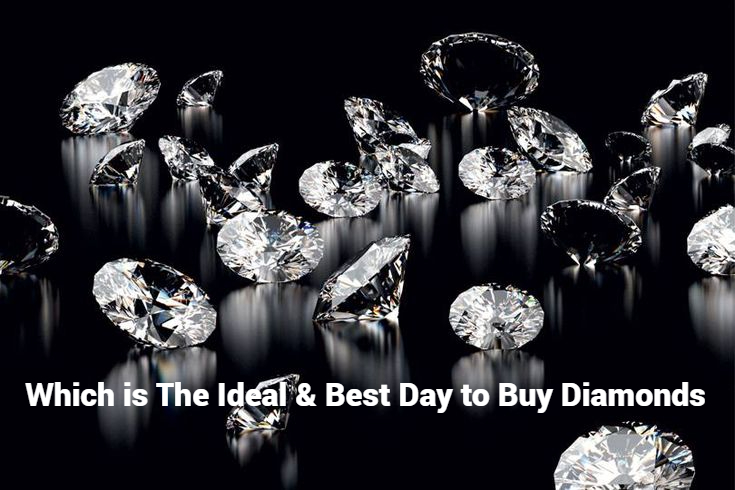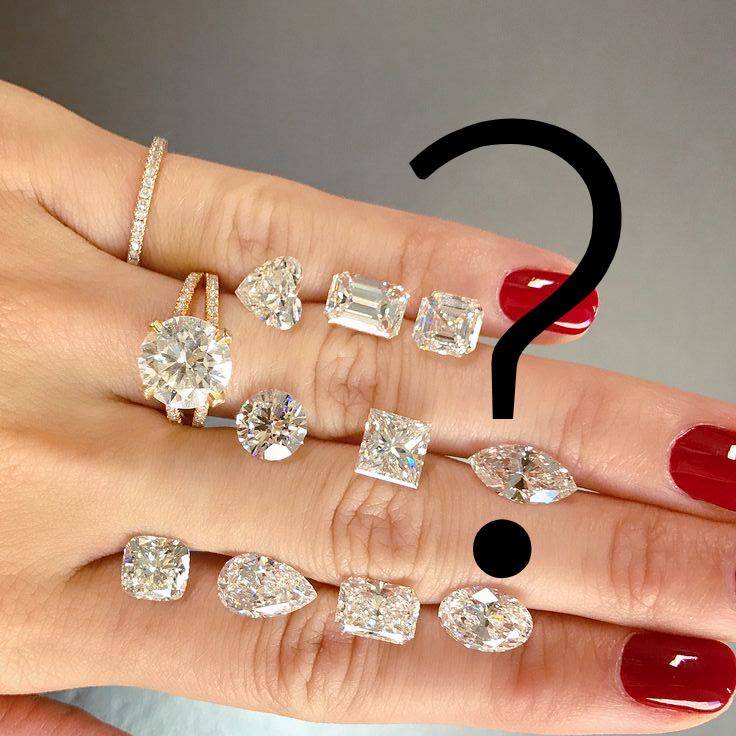If you want to know anything and everything about diamond cut, then you have come to the right place. This article would help you understand the following things:
The reasons why cut is so important:
-
- The cut is the most important determinant of quality
- Cut refines the diamond
- Cut determines the price
- Different shapes are obtained during cutting
- Cut grading helps the buyer to select the best
The different types of cut which include:
-
- Pointcut
- Table cut
- Old single cut
- Mazarin cut
- Peruzzi cut
- Old European cut
- Round brilliant cut
- Fancy cut
Diamond cut proportions that are expected for each of the table, depth, the girdle, the crown, the pavilion, the culet
GIA diamond cut grading system which includes:
-
- Excellent
- Very good
- Good
- Fair
- Poor
One of the characteristics of light is a reflection. This means that light bounces off a surface and changes its direction. This characteristic of light is also very important in the world of diamonds.
When light hits a diamond, it is supposed to be reflected in a regular, coordinated and ordered pattern. When this is done, we can then observe the beauty that comes from the reflection of light by the diamond.
A diamond has several characteristics, but the one which is most important for the reflection and consequently sparkle produced by itis the cut.
When it comes to cut, we are referring to the most important quality of a diamond. It is a measure of light performance when a diamond is exposed to light. It takes several factors into consideration including the polishing, the symmetry and the proportioning of the diamond. The cut of a diamond would always determine the interaction of the diamond with light; a diamond with an excellent cut would always stand out and reflect light better than one that is poorly cut.
The diamond-cut does not refer primarily to the shape of the diamond, for instance, round, oval, pear, rather, it refers to a measure of how many factors have come together to produce a diamond that can interact well with light and produce a very strong visual appeal.
THE IMPORTANCE OF CUT
You might then be asking, why do we even have to cut diamonds in the first place?
Good question.
The cut is important for the following reasons:
- IT IS THE MOST IMPORTANT DETERMINANT OF QUALITY: The diamond cut is the most important C of diamonds. When a diamond is well cut, the diamond would appear beautiful and visually appealing. If it is poorly cut, the diamond would look so dull and lifeless. This is because the cut determines how well the diamond interacts with light. It is no surprise therefore, that diamonds are graded based on their cut.
- THE CUT REFINES THE DIAMOND: The cut of a diamond is what takes it from being a rough, unattractive element to a shiny, polished and adorable gemstone. It is the refinement process of the diamond. No one wants to wear a rough stone after all!
- IT DETERMINES THE PRICE: The cut of the diamond also determines the price of the diamond. First, the rough stone is not as valuable as a cut and polished diamond. Secondly, among different types of cuts, the prices are not the same. For brilliant cuts for instance, while cutting, a lot of rough diamond would be wasted, making it more expensive. But for some fancy cuts, more diamond is saved and so it is not as expensive as the brilliant-cut.
- DIFFERENT SHAPES ARE PRODUCED IN CUTTING: As a result of different patterns of cutting and arrangements, different shapes have been discovered over the years. There are now different shapes that buyers can pick from, based on their preferences and what the diamond is needed for. The cut is usually the major difference!
- CUT GRADING HELPS THE BUYER TO SELECT THE BEST: Armed with this information about the different cuts and what distinguishes them, a buyer can make the best decision on what to buy or what to avoid.
TYPES OF CUT
Now, we understand that diamonds are cut to enhance their appearance among other reasons.
The practice of cutting diamonds started as far back as the middle ages (sometime between the 5th and 15th centuries). Before this time, diamonds were not cut; rather they were used as rough as they appeared naturally. The uncut diamonds were not as shiny and appealing as the ones we have around today and as a matter of fact, they were not popular as jewelry.
As people advanced, however, they began to explore ways to enhance the appearance of diamonds. They found that by cutting some of the edges to look even and smooth they could make the diamond more attractive. The different types of cut over the years are:
- The pointcut: This is arguably the first type of cut. It involved polishing and removing uneven blemishes in the diamond so that the octahedral shape was more evident. This cut was also achieved by carving the octahedral shape out of a rough diamond. It started in the 14th century and was very popular among the people then.
- The Table cut: As more progress was made in the gem world, more improvements were made on the pointcut and this resulted in the table cut. The table cut had the top part of the point cut’s octahedron removed so that the top was now flat as a table. This cut allowed more light to enter and some designs of the table cut also had another feature which was called the culet, the base of the diamond.
- The Old single cut: This cut saw the introduction of four corner facets in the cutting of diamonds.
In this era, the diamonds were not known for the brilliance and fire that they are now popular for.
- The Mazarin cut: This cut was the first brilliant cut introduced. Brilliant because it was designed to reflect light better and had more scintillation than other cuts before it. The Mazarin cut was introduced in the 17th century and had 17 facets.
- The Peruzzi cut was an update on the Mazarin cut. Vincent Peruzzi, a diamond polisher, decided to increase the number of facets on the Mazarin from 17 to 33, thereby creating a new cut that had more brilliance and fire.
- The Old European cut: This was introduced in the 19th century and was the forerunner of the modern brilliant cuts that we have today. It had a higher and different arrangement of facets, a pavilion which was not as deep as previous cuts, was rounder and had a better reflection.
- The round brilliant cut: This cut was developed by Marcel Tolkowsky in 1919 and has since become the most popular type of diamond in demand. The development of this cut was a result of improvement in technology and the addition of diamond saws and jewelry lathes. This cut emphasizes symmetry in facet arrangement, fire, and brilliance. It became the bedrock for other brilliant cuts and modifications.
- The fancy cut: Has been around for a long time, coming in between periods, depending on the history and culture of the people in different places. Fancy cuts are heavily influenced by the fashion trend in the location. Diamonds are cut into different shapes and sizes based on people’s preferences.
It is important to note that not all diamonds are cut for brilliance or sparkle. Some are cut for their shape and others are cut for some other characteristic like clarity. This preference is particularly seen among the fancy cuts like the heart-shaped cut, the Asscher cut, and others.
DIAMOND CUT PROPORTIONS
The diamond cut proportion refers to the ideal interaction between the shape, the size and the angle of all the facets that are present in a diamond.
Generally speaking, when light enters a diamond, about eighty percent of the amount of light that enters passes through the stone while the remaining twenty percent is reflected as glare. The ability of a diamond to optimally maximize the light passing through it to create brilliance, fire, and scintillation is largely dependent on how well it has been cut.
Before we proceed, there are some features of a diamond we should examine:
- The refractive index: The refractive index of a diamond refers to its ability to bend light as light passes through it. This index is responsible for the brilliance of the diamond, that is, the amount of light that is reflected in the eye of the viewer.
- Brilliance: can be defined as the ability of a diamond to reflect light to the observer. It is highly dependent on the refractive index. It can be of two types: external and internal brilliance. External brilliance refers to the reflection of light that happens at the surface of the stone, while internal brilliance refers to the reflection that happens inside the stone, at the pavilion. This depends on how well the diamond has been cut.
- Dispersive power: This term refers to the ability of the diamond to split light into its component colors. From physics, we understand white light is made up of several other colors of light. How well a diamond can split the light is a function of its dispersive power.
- Fire: Fire is the pattern of different colors seen when a diamond splits white light into various colors. It follows then that the higher the dispersive power of the diamond, the more the fire produced and vice versa.
- Scintillation: Scintillation refers to the areas of sparkle which are seen on the diamond. It is caused by the light and dark areas that are visible on the diamond and also the dispersion 0f light. It is affected by the size, number and symmetry of the facets when they are cut.
Having examined these features, we now go to the parts and proportions which would produce these features excellently.
- THE TABLE: The diamond table is the largest part of the diamond. It is the part through which light goes in and also through which light has reflected the eye. This table refracts light to the facets which make the diamond sparkle when viewed. The physical size of the diamond table varies with the overall size of the diamond. It is for this reason that diamond cutters generally measure the table percentage of a diamond. Based on the shape of the diamond, the diamond table size would also vary. For example, the excellent cut grade for the round cut diamond has a percentage range of 53 – 59. This is not the same for every other shape.
| Excellent | Very good | |
| Round cut | 53 – 59 | 51 – 53
or 58 – 60 |
| Asscher cut | <69
|
70 – 72
|
| Marquis cut | 53 – 63
|
52
Or 64. 0 – 65.5 |
| Pear cut | 53 – 63
|
52
Or 64. 0 – 65.0 |
| Heart cut | 53 – 63
|
52
Or 64. 0 – 65.0 |
| Cushion-Cut | 61 – 67.9 | 58 – 60
Or 61 – 70 |
These reference ranges would guide your choice in what to expect when buying any of the diamonds.
- THE DEPTH: Another essential and significant part of the diamond cut is the depth. The depth of a diamond refers to the measurement from the top to the base (the culet). Diamond cutters pay so much attention to this because it would influence the appearance of the diamond. When a diamond is too shallow, that is, the depth has a lower than expected value, the diamond would lose a lot of light passing through and appear dull and less appealing.
On the flip side, when a diamond is cut with too much depth, the diamond tends to look smaller in size. The reason for this is that the reflecting surfaces (Pavilions) are now more distant from the point light enters and leaves the diamond. If a diamond of the same size, but lesser depth is placed side by side with it, the one with lesser depth would appear bigger and thicker.
What to expect in terms of the depth of a diamond:
–
| EXCELLENT | VERY GOOD | |
| ROUND CUT | 59 – 62
|
58 – 58.9
or 61.9 – 63 |
| ASSCHER CUT | 61 – 68 | 59.0 – 60.9
or 67.1 – 70.0 |
| MARQUISE CUT | 58 – 62 | 56.0 – 57.9
or 62.1 – 66.0 |
| CUSHION CUT | 61 – 67 | 58 – 60.9
Or
67.1 – 70 |
| PEAR CUT | 58 – 62 | 56.0 – 57.9
or 62.1 – 66.0 |
- THE CROWN: The crown of a diamond is located just below the table and above the girdle. It is the part through which the largest amount of light enters and leaves the diamond. The crown is essential to the sparkle and brilliance of a diamond and so must be angled appropriately. Most ideal crown angles should range from 34 to 36 degrees.
- THE GIRDLE: The girdle refers to a thin portion just below the crown and above the pavilion. It s usually the widest part of the diamond where the width is measured. It can be set in facets, polished or unpolished. In diamond cut, attention is paid to the girdle because if itis too thin, it could easily get chipped off, while if it is too thick, it could obstruct the passage of light and create reflections. These reflections could also create dark areas that would reduce the sparkle and brilliance of the diamond.
For most of the cuts, for excellent and very good grades, the expected girdle thickness should range from Very thin to slightly thick.
In this range, the girdle would allow the optimal passage of light while remaining durable.
- PAVILLION: The pavilion of a diamond is the part just below the girdle. This part reflects light after it has entered the diamond. In cutting a diamond, there are two parameters that the pavilion must cover: the depth and the angle. The pavilion depth is expected to fall within a specific range of values, depending on the type of cut. The same also goes for the pavilion angle. If the depth is higher or lower than expected, the light would just pass through instead of being reflected. This would affect the brilliance of the diamond because the sparkle seen on any diamond is a function of the reflection of light. The pavilion is cut at an angle to the girdle and culet to sufficiently refract light. If this is not done properly, the light would be lost as it passes through the diamond.
For most cuts, the expected pavilion depth for the excellent cut is 42- 43% while for the very good cut, it is 41.0 – 41.9 or 43.0 – 43.9. The recommended angle can be between 40and 42 degrees.
- THE CULET: The culet is the lowest point of the diamond. When cutting, a lot of weight is usually concentrated at the culet of the diamond. It is the point at which all the facets converge. It is usually sealed off to prevent light leakage, so a slight enters the diamond it bounces off the pavilions and back to the observer’s eye. Most diamonds with unsealed culets tend to have a lot of light leakage. The culet is also usually the weakest part of the diamond because of its pointed edge. It could easily be chipped off which would affect the diamond’s appearance and sparkle. This is one of the reasons why it is usually set in prongs. Prongs protect the point edges and prevent them from being chipped off.
To prevent light leakage, an excellent cut grade diamond at the culet is completely sealed, which is graded as ‘None’ while for a very good grade diamond, the culet is small.
GIA DIAMOND CUT GRADING
- Excellent: This cut grade represents the top 3% of jewelry quality diamonds in the world today. All the parts of the diamond are cut to perfection and nothing is out of place.
- Very good: This cut grade refers to the top 15% of diamonds. It also has brilliant sparkle, minimal light leakage, and good scintillation.
- Good: This grade represents the top 25% of the lot. It sparkles well but exhibits some light leakage.
- Fair: This cut grade has average proportions, but there is significant light leakage which affects its sparkle. This grade would not make for visually appealing jewelry.
- Poor: Lowest grade, with poor standard measurements and ratios. It would not qualify for visually appealing jewelry



